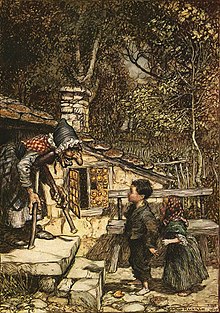Hansel and Gretel
"Hansel and Gretel" (German: Hänsel und Grethel) is a fairy tale from Germany. The Brothers Grimm heard it from Dortchen Wild in Cassel and published it in their Children's and Household Tales in 1812. The Grimms revised the tale over the years. They gave the children names, changed the mother to a stepmother, and introduced Christian motifs. Their final version is dated 1857. The tale has been adapted to many media, most notably the opera Hänsel und Gretel (1893) by Engelbert Humperdinck. A stop-motion animated movie based on the opera was made in the 1950s.

Story
changeHansel and Gretel are a young brother and sister who learn their parents intend to abandon them in the forest. Despite their situation, Hansel and Gretel’s spirits remained high.They find their way home by leaving a trail of pebbles. One day, however, their parents succeed. The children wander the forest and come upon a house made of cake and candy. It belongs to an old woman who makes the children prisoners. Although, she intends to eat them, she fails. Gretel outwits her. She pushes the old woman into the oven and slams the door. The two poor kids escaped and lived happily ever after.
References
change- Opie, Iona and Peter. 1974. The Classic Fairy Tales. Oxford UP. pp. 236-7.
- Tatar, Maria. 2002. The Annoted Classic Fairy Tales. Norton. pp. 44-5.
- Zipes, Jack (Ed.) 2002. The Oxford Companion to Fairy Tales. Norton. pp. 225-6.